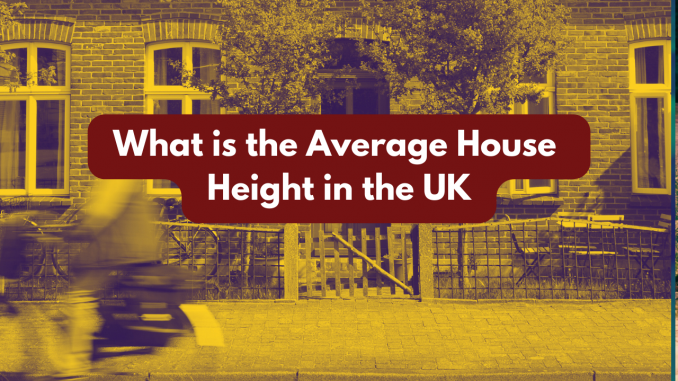
Typically, a standard two-story house in the UK might have a height of around 8 to 10 meters (26 to 33 feet) from ground to roof ridge.
How Tall is a House in the UK?
It’s important to note that this is a rough estimate and not an exact measurement. There are various factors that can influence the height of houses and these factors can influence the size and layout of houses in the UK. Here are some key factors that can impact the standard size of houses:
How Tall is a 2 Story House in the UK?
In the UK, the typical height of a two-story house ranges from around 5.5 meters (18 feet) to 6.5 meters (21 feet) from the ground level to the roof ridge. However, this can vary based on factors such as architectural style, local building regulations, and individual design choices.
Additionally, the height of each story (floor-to-ceiling height) is generally around 2.4 meters (8 feet) to 2.7 meters (9 feet) per story. It’s important to note that these are general guidelines, and actual dimensions can vary depending on the specific circumstances of the property.
How Tall is a 3 Story House in the UK?
In the UK, the typical height of a three-story house can range from approximately 8 meters (26 feet) to 9.5 meters (31 feet) from ground level to the roof ridge. This height includes the combined height of all three floors as well as the roof structure. Each story typically has a floor-to-ceiling height of around 2.4 meters (8 feet) to 2.7 meters (9 feet).
However, these measurements can vary based on factors such as architectural design, local building regulations, and individual preferences. It’s essential to consult specific plans or local building authorities for accurate measurements and requirements when constructing or assessing the height of a three-story house in the UK.
How Tall is a Bungalow?
The height of a bungalow can vary depending on various factors such as architectural style, local building codes, and design preferences. However, bungalows are typically single-story dwellings, meaning they have all their living space on one level. As a result, the height of a bungalow is generally lower than that of multi-story houses.
In terms of specific measurements, the height of a bungalow is often around 8 to 12 feet (2.4 to 3.7 meters) from the ground level to the roof ridge. This measurement can vary based on factors such as roof pitch, ceiling height, and architectural design. Additionally, some bungalows may have sloped roofs or dormer windows, which can affect their overall height. It’s essential to consider these factors when determining the height of a particular bungalow design.
What influences the height of a house?
Planning Regulations
Local planning regulations play a significant role in determining the size and dimensions of houses. These regulations set guidelines on factors such as building height, setbacks, plot coverage, and overall floor area. They ensure that new constructions align with the desired aesthetic, environmental, and community standards of the area.
Land Availability and Cost
The availability and cost of land can influence the size of houses. In areas with limited land availability or higher land costs, houses may be built with smaller footprints or vertically with multiple stories to maximise space.
Architectural Styles
Architectural styles prevalent in a region or era can impact the size of houses. Different styles may have varying ceiling heights, door sizes, floor plans, bedroom sizes, room layouts, and overall square footage. Traditional architectural styles may have different standards than modern or contemporary designs.
Demographics and Lifestyle Preferences
The needs and preferences of homeowners can influence the size of houses. Factors like household size, family composition, and cultural preferences can impact the desired number of bedrooms, bathrooms, living spaces, and overall square footage.
Economic Factors
Economic factors, such as construction costs, land prices, and market demand, can influence the size of houses. In some cases, economic constraints may lead to smaller, more compact designs, while in other cases, economic prosperity may encourage larger, more spacious houses.
Environmental Considerations
Energy efficiency and sustainability requirements can influence the size and design of houses. Regulations promoting sustainable building practices may lead to considerations like smaller floor areas, efficient space utilisation, and environmentally friendly features.

Regional and Local Context
Different regions within the UK may have their own building traditions, cultural norms, and architectural preferences. Factors such as climate, historical context, and local building practices can influence the standard size and layout of houses in a particular area.
It’s important to note that these factors can vary and evolve over time, resulting in a diverse range of house sizes and designs throughout the UK.


Leave a Reply